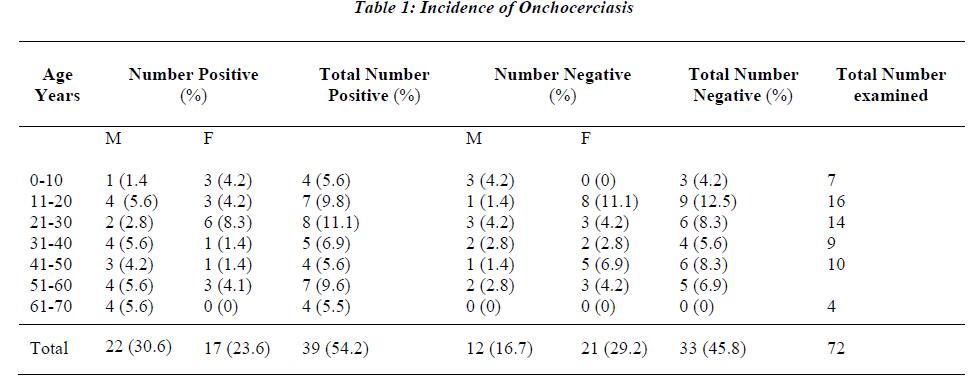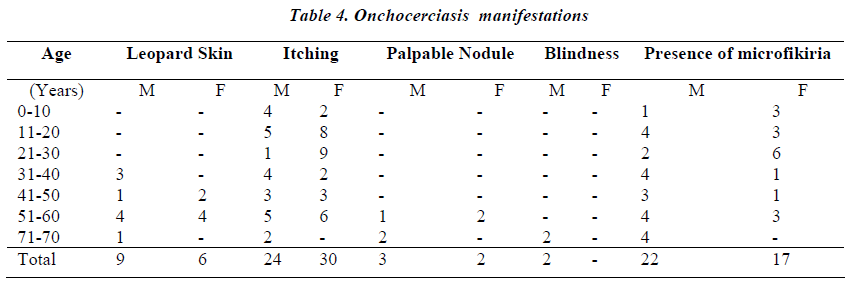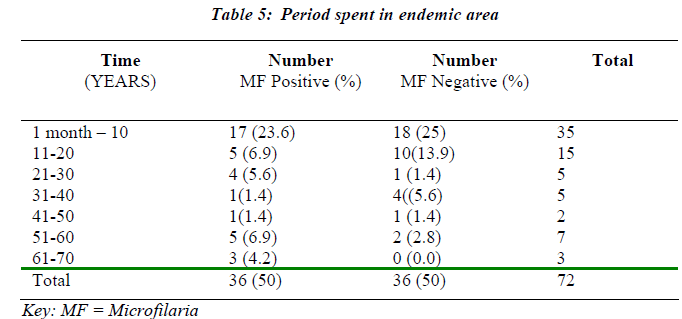- Biomedical Research (2010) Volume 21, Issue 2
Onchocerciasis among inhabitants of Ibarapa local government community of Oyo state, Nigeria
1Akinboye, D.O.; 2Okwong, E., 3Ajiteru N., 4Fawole O. 5Agbolade, O., M.; 6Ayinde,O.O., 1*Amosu, A. M.; 1Atulomah, N.O.S.; 7Oduola, O.; 8Owodunni,B.M.; 9Rebecca,S.N., 10 Falade, M.
11Department of Public and Allied Health, Babcock University, Ilisan-Remo
22Department of Medical Laboratory Science, Uni-versity of Calabar
3Environmental Department, Ibarapa East Local Government, Eruwa
44Department of Epidemiology and Medical Statistics, Faculty of Public Health, College of Medicine,University College Hospital,Ibadan
5Department of Sci-ence and Applied Zoology, Olabisi Onabanjo University, PMB 2002, Ago-Iwoye
6Department of Planning, Research and Statistics, Ministry of Health, Secretariat, Ibadan, Oyo State.
7Department of Pharmacology and Therapeuthics, Ladoke Akin-tola University, Oshogbo.
8Federal Polytechnic, Kaura Namoda, Zamfara State.
9Deparment of Biology, Federal University of Technology, Yola.
10Protein Ligand Engineering and Molecular Biology Laboratory, National Center for Genetic Engineering and Biotechnology, 113 Thailand Science Park, Phaholyothin Road, Klong 1, Klongluang, Pathumthani 12120 Thailand.
- *Corresponding Author:
- A.M. Amosu
Department of Public and Allied Health
Babcock University, Ilishan-Remo,Ogun State
Nigeria
Tel: +234-805-302-6584
E-mail: dlivingrock2004@yahoo.com
Accepted date: August 28 2010
Abstract
This descriptive study on onchocerciasis was conducted among 72 randomly selected inhabitants of a rural community, in Oyo State, Nigeria, during the planting season between the months of April and June. Demographic information, the length of time the subjects had lived in the study area and previous treatments received for the disease (if any), were obtained using a question-naire. The effect of ivermectin administration was investigated in the study area. The objectives of the study were to identify the age brackets and occupation of the inhabitants at high risk, and to determine the severity of infection in the study area. Four skin snips were obtained from both scapular regions and the two gluteal folds of each participant, and examined for microfilaria of Onchocerca volvulus .Data were analyzed using the SPSS version 12.0, involving descriptive statis-tics, frequencies, percentages and the student t-test to test for significance. Thirty-nine, (54%) of the subjects were infected with onchocerciasis. Microfilaria count in the skin was higher among males (30.5%) than in females (23.6%), although there was no significant difference. Subjects be-tween the ages of 21-30 years had higher positivity of 11.1%, while those between 11-20 years had 9.8%. The presence of “Leopard skin” and palpable onchocerca nodules were 20.8% and 6.9% respectively. The frequency of blindness was 2.7%, while there was an association between occupa-tion and severity of infection. There was an association between itching and the presence of microfilaria. The importance of onchocerciasis control programmes in the study area is high-lighted.
Key words
Onchocerciasis, Microfilaria, Leopard skin, Occupation, Infection.
Introduction
Onchocerciasis is increasingly recognized as a major disease of public health importance in endemic parts of the world, with sub-Saharan Africa, especially West Africa, being the most hyper endemic foci in the world The disease has been widely reported in Nigeria, where about 7 million people are infected and another 40 million were at risk of infection [1]. Onchocerciasis is basically a rural disease affecting communities sited along fast-flowing rivers, which enable the breeding of the vector, Simulium,resulting in infection with Onchocerca volvulus, among the inhabitants of the area. The symptoms of the disease are particularly irritating and disabling, often associated with long-term ex-posure to infection, and this affects the social and economic activities of the inhabitants concerned [2]. The implications of the disease bring about the need to control onchocerciasis [3].
The objectives of this study were to identify the age brackets and occupation of those at high risk of infection, the epidemiology of the disease, frequency of blindness, leopard skin and palpable nodules in the Ibarapa community.
Materials and Methods
Idi-Ata, the village where the study was conducted has a population of 880 people. It is a Yoruba farming community, located on the outskirts of Eruwa, the headquarters of Ibarapa local government area of Oyo state, Nigeria. The area is situated in the forest-savanna region with the characteristic vegetation interspaced with rocks. The River Ogun flows close to the village, less than a kilometer away and is the only source of water for the community. It also serves as the breeding site for the Simuluim species in the area.
The study was carried out during the planting season between the months of April and June, 2008. One hundred and ten subjects were randomly selected out of which 72 consented and participated in this study. The remaining 38 subjects backed out at the stage of specimen collection for personal reasons. Data was collected with a questionnaire to obtain name, age, gender, marital status, occupation, length of time spent in the study area and previous treatments received for the disease, (if any).
Four skin snips were aseptically obtained from each subject from both scapular regions (shoulder blades), and the two gluteal folds (buttocks), using a Holth-type corneoscleral punch with a 1.5mm bite. The punch was treated with glutaraldehyde and sodium hypochlorite solution and rinsed with distilled water and alcohol to prevent the The skin snips were then placed in microtitre wells, containing 0.3ml of Phosphate Buffer Saline (PBS), and covered with cellophane to prevent evaporation and spillage during handling.
Some of the liquid contents were placed on a microscope slide using a Pasteur pipette, and examined under the micro-scope at x10 magnification, for the presence of Onchocera volvulus microfilariae. The microtitre plates containing skin snips were further incubated in a water bath at 37°C for 24 hours, and re-examined for microfilariae when samples were negative. The results obtained were compared using the student t-test for test of significance.
Results
Out of the seventy-two people examined for O. volvulus microfilariae, 39 (54.2%) were infected. The prevalence of microfilariae in the skin was higher among males (30.6%) than in females (23.6%), although there was no significant difference. The prevalence of infection varied with the age-groups. Subjects between ages of 21-30 years had a higher prevalence of 11.1%, closely followed by 9.8% in the 11-20 age group, and 9.6% infection rate within the 51-60 years age group (Table 1).
The effect of previous treatment on the manifestation of disease, is represented in Table 2, symptoms being more marked in those who were never treated for the infection.
There was a significant association between infection rates and occupation, (Table 3), in which farmers demonstrated a higher rate of 31.9%, compared with 12.5% among students and 8.3% recorded for traders.
Advanced forms of Onchocerciasis, represented by “Leopard skin”, Onchocercal nodules, blindness, etc, were observed with increase in age. Skin manifestations of the disease were observed only in cases where total blindness was recorded for visual impairment. Table 4 shows the Leopard skin de
pigmentation occurring in 15 (20.8%) persons examined, mostly above 30 years of age, the prevalence of nodules was low, 5 (6.9%), located on the trunk, waist and thigh. Only two cases of total blindness were observed in the village and both were males of above 60 years of age.
Residents who had spent about ten years in the endemic area, showed a high prevalence of skin microfilaria (23.6%) as compared to long time residents of about thirty (30) years or more, especially those who had spent their entire lifetime, (up to the present), in the area. This latter group demonstrated marked manifestation of disease as shown in Table 5.
Discussion
The endemicity of onchoceriasis has been established in the study area, by various workers [6,7,8]. The prevalence of onchocerciasis in Idi-Ata village is relatively high, with 54.2% infection rate among the subjects examined (Table 3). This is similar to an earlier work in the same area, where a prevalence of 48.8% was observed [7].
The high risk age groups were mostly thirty years and above (Table 1), making up the main working population. This group recorded higher rates of skin microfilaria, showing a progressive increase in infection with age. The rates decreased suddenly at about sixty years of age, although this group exhibited marked clinical manifesttations of onchocer-ciasis. It was also observed in Kwara state, Nigeria, that older subjects had a prevalence of 54%, with intensity of infection increasing with age [2]. A similar observation was made by other researchers in Garaha-Dutse community, Adamawa state, Nigeria [9]. The increased transmission of infection could be influenced by the degree of exposure of members of the main working
population, to the infective bites of S. damnosum the local vector of the disease. This in turn, is influenced by the number of people in each age-group concerned, their activities, and the culture of dressing among the people.
The breeding of i, along the bank of River Ogun, has been described[10]. Since the river was less than one kilometer from the village settlement, the vectors were abundant in the village and therefore bite the inhabitants freely. Various activities that are mainly outdoors also expose the people to infective bites of the files.
Farming was the major occupation of the community. All members of the community, comprising males and females were affected. There was a significant relationship between different occupation and the rate of infection, thus, exclusively, farmers had higher rates of infections because of their greater bodily exposure, to fly bites. They are therefore regarded as a highrisk group like the cattle-rearers and fishermen [11].
Prevalence of infection was higher in the male subjects, despite the relatively equal exposure to infection by both male and female subjects. This is similar to the findings of other workers in which the clinical features of the infected males were higher compared to the females [12,13,14]. The variation has been attributed to differences in degree and duration of exposure to the infective bites of the local Simulium species. The advanced stages of onchocerciasis represented by “Leopard skin”, presence of palpable nodules, scaly skin (lizard skin”) and blindness, were indications of longstanding infection with Onchocerca volvulus, especially common among residents who had spent considerable length of time in the village, (about 30 years or more). The conditions were determined by repeated bites of the vector, irrespective of age, although the conditions were rare among young children [15].
Conclusion
The treatment of Onchocerciasis with ivermectin (Mecti-azan, MSD) was viewed as very successful in some areas where the presence of microfilaria was found to be reduced. Also, the incidence of infection and disease complications were drastically reduced among subjects previously treated with the drug. The consistent distribution of this drug in the study area, and in other endemic communities, will greatly reduce the number of skin microfilaria, thereby controlling the transmission of infection.
The importance of onchocerciasis control programmes in endemic communities should be highlighted. Consistent administration of ivermectin to the most active age groups in these areas, as shown in this study, should be emphasized.
Acknowledgement
The contribution of Prof. O. Oladepo, Department of Health Promotion sand Education, College of Medicine, University of Ibadan, Ibadan, is highly appreciated.
References
- Anosike JC, Onwuliri COE. Studies on Filariasis in Bauchi State, Nigeria1. Endemicity of human Onchoce-rciasis in Ningi Local Government Area. Ann Trop Med Parasitol 1983; 89 (1): 31-38.
- Edungbola LA, Asaolu SO. Parasitologic Survey of Onchocerciasis (River blindness) in Babana District, Kwara State, Nigeria Amer J Trop Med hyg 1984; 33(6): 1147-1154.
- Akinboye DO. Immunological Studies on the mecha-nism of resistance in experimental onchocerciasis, Af-rican Journal of Science and Technology 2001; 1(4) 1-13.
- Collins FC, Gonzales-Peralta C, Castro J, Zea-Flores C, Cupp MS, Richards FO, Cupp EW. Ivermectin: Reduc-tion in prevalence and infection intensity of Oncho-cerca volvulus following biannual treatment in five Guatemalan communities. Am Trop Med Hyg 1992; 47 (2): 156-169.
- Oyibo WA, Fagbenro-Beyioku AF. Effect of repeated community based ivermectin treatment on the intensity of Onchocerciasis in Nigeria. Rural Remote Health J. 2003: 3: 311-316 6. Wyatt GB. Onchocerciasis in Ibarapa, Western State, Nigeria. Ann Trop Med Parasitol 1971; 65(4): 513-523.
- Ogunba EO. Epidemiological Aspects of Human Onc-hocerciasis in Ibarapa Division, Oyo State, Nigeria. In: Proceedings of the First National Conference on Onch-ocerciasis 1982; 1: 40-43, NITR, Kaduna.
- Brieger WR, Ramakrishna J, Adeniyi JD, Pearson A. C. Kale, O.O. Onchocerciasis and Pregnancy. Tropical Doctor 1987; 17: 171-174.
- Rebecca SN, Akinboye DO, Abdulazeez AA. Oncho-cerciasis and plasmodiasiss: concurrent infection in Garaha-Dutse community, Adamawa Srate Nigeria. Biomedical Research 2008; 19: 2. ?page numbers?
- Crosskey RW. An Appraisal of Current Knowledge of Simulium damnosum S.C. in the Federal Republic of Nigeria. An Onchocerciasis control campaign.World Health Organization WHO/VBC/79 171, WHO-ONCHO/79 150.
- Ezike VI, Roberts DM. Onchocerciasis infection Rate of villagers at three distances from the Oji River Simu-lium damnosum complex breeding sites in Nigeria. In: Proceedings of the First National Conference on On-chocerciasis 1982; 1, NITR, Kaduna.
- Gemade EI, Dipeolu OO. Onchocerciasis in the Benue State of Nigeria 11. Prevalence of the Disease among the Tivs Living in Kwande Local Government Area. Ann Trop Med Parasitol 1983; 77 (5): 513-515
- Bocharie MJ, Davies JB. The Transmission of Oncho-cerciasis at a Forest Village in Sierra Leone 11. Man-Fly Contact, Human activity and Exposure to Trans-mission. Ann Trop Med. Parasitol 1990; 84(6): 599-605.
- Okonkwo P, Akpa A, Ihekwaba A, Nwagbo D, Umeh K, Adibua S, Ezike V, Ogbuokin S. Studies on Oncho-cerciasis in the Forest-Savanna Mosaic Area of Nigeria 1 investigations in Gabragu, Oji River. Ann Trop Med Parasitol 1991; 85: 617-623.
- Browne SG. Onchocercal Depigmentation.Tran R Soc Trop Med Hyg 1960: 54 (4): 325-330.
- Browne SG. Onchocercal Depigmentation.Tran R Soc Trop Med Hyg 1960: 54 (4): 325-330.




